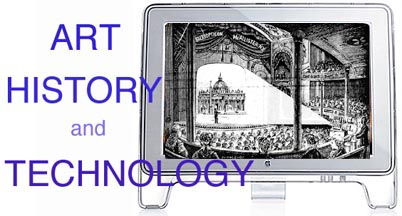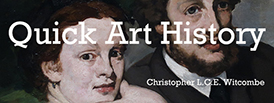

A BRIEF HISTORY
4 - Teaching Art History
The roots of art history teaching are to be found in the lectures given at the various art academies beginning in the 16th century. The first program of lectures was that organized in 1594 by Federico Zuccaro, the Principe of the Accademia di San Luca in Rome. At first, the lecturers were artist members of the academy, but in the 17th century, lectures by non-artist members were also included.
In Rome, Giovanni Pietro Bellori set forth his artistic theories in an essay which he read to the members of the Accademia di San Luca in 1664 (later published as the preface to his Lives). The French Academy instituted a similar program with lectures open to the public in the form of a conférence in which discussion took place focussed on specific paintings. In 1667, Charles Le Brun, director of the academy, conducted a conférence in which Nicolas Poussin's painting, The Israelites Gathering Manna, was analyzed in terms of composition, drawing, proportion, expression, and lighting effects.
Le Brun and his audience were fortunate in that the lecture was conducted with Poussin's painting at hand. Moreover, the painting (now in the Louvre) is large, 4 feet 103/4 inches by 6 feet 63/4 inches, which meant that everyone in the audience could see with their own eyes what he was talking about.
But how did Bellori's lecture, given a few years earlier in Rome, go over? The paintings he refers to specifically, such as Raphael's Galatea, Guido Reni's St. Michael, were not present in the lecture room, nor were the ancient sculptures he mentions. The paintings and some of the sculptures were in Rome and could have been seen before or after the lecture, but the lecture itself was given, as far as we know, without any "visual aids." In other words, Bellori's lecture was not illustrated and so he had to rely on the assumption that his audience would be familiar with the works he mentions.
Already in the 17th century the problem is this. The availability of casts and prints had expanded the scope of art history. Reproductive prints allowed one to compare and contrast a painting in Rome with a painting in Venice. This ability quickly came to define a central activity for the art historian. While Le Brun might focus a conférence on a single painting at hand, the art history lecture, like Bellori's, now ranged beyond what was immediately visible to the audience and included works located in distant places.
As the study of art history took shape around "study aids" - reproductive prints and plaster casts - the art history lecture consequently became more difficult. Because the discipline is a visual one, the desire is to show the audience what you are referring to, but how do you do this in a lecture? The useful "study aids" are practically useless as "visual aids" in the lecture hall. It is difficult to move full-scale plaster casts into the lecture hall as needed, while holding aloft copper-plate prints, which are generally rather small in size, would be difficult to see across a large and crowded room.
When Sir Joshua Reynolds lectured at the Royal Academy in London, beginning in 1769, several hundred people commonly assembled to hear him. His lectures were not illustrated. However, he was aware of the problem and tried, when the opportunity allows, to refer to works near at hand, such as a cast of the head of Neptune by Bernini in the collection of the Academy (Discourse X), and to the Raphael Cartoons (then at Buckingham House, from 1763 to 1787, then moved to Windsor, and today in the V&A). With regard to the latter, he explained that "I have given examples from those pictures only of Raffaelle which we have among us" (Discourse XII). At other times, however, he could not avoid referring to paintings in distant places, such as specific works by Lodovico Carracci for which he apologized saying "It is our misfortune, however, that those works of Carrache which I recommend to the Student, are not often found outside Bologna" (Discourse II).
The desire to find some way to illustrate art history lectures in some cases resulted in the laborious production of enlarged drawings and diagrams. John Soane, for example, who lectured at the Royal academy for nearly thirty years, amassed some 2,000 display drawings of architecture, most of them measuring four feet by two feet and coloured for effect (the collection is still housed in Sir John Soane's Museum in London).
Photographs, after they became available in the 1840s, were of little help because, like reproductive prints, they were small in size. What was needed was some form of enlarged photograph. Technology came to the rescue in 1850 with the invention of a transparent positive image of a photograph in the form of a glass slide that could be projected onto a wall or screen using a Magic Lantern.
|


 1
1  4 Teaching Art History
4 Teaching Art History